#AI automation tools.
Explore tagged Tumblr posts
Text
External AI Tools Overview
Chapter 1. Introduction 1.1. Overview of AI in Today’s Market 1.2. Importance of AI Tools in Business Optimization 1.3. Purpose and Scope of the Article Chapter 2. Understanding Market Dynamics with Aurora 2.1. Key Features of Aurora 2.2. Benefits for Market Analysis 2.3. Case Studies: Successful Implementations Chapter 3. Streamlining Processes with Metastory 3.1. Overview of Requirements…
#AI automation tools.#AI business tools#AI chatbots#AI content creation#AI detection tools#AI features#AI platforms#AI pricing#AI productivity tools#AI search engines#AI tool library#AI tools 2025#AI tools directory#AI translation tools#AI use cases#AI writing assistant#AI writing tools#best AI tools#free AI tools#top AI tools
0 notes
Note
As cameras becomes more normalized (Sarah Bernhardt encouraging it, grifters on the rise, young artists using it), I wanna express how I will never turn to it because it fundamentally bores me to my core. There is no reason for me to want to use cameras because I will never want to give up my autonomy in creating art. I never want to become reliant on an inhuman object for expression, least of all if that object is created and controlled by manufacturing companies. I paint not because I want a painting but because I love the process of painting. So even in a future where everyone’s accepted it, I’m never gonna sway on this.
if i have to explain to you that using a camera to take a picture is not the same as using generative ai to generate an image then you are a fucking moron.
#ask me#anon#no more patience for this#i've heard this for the past 2 years#“an object created and controlled by companies” anon the company cannot barge into your home and take your camera away#or randomly change how it works on a whim. you OWN the camera that's the whole POINT#the entire point of a camera is that i can control it and my body to produce art. photography is one of the most PHYSICAL forms of artmakin#you have to communicate with your space and subjects and be conscious of your position in a physical world.#that's what makes a camera a tool. generative ai (if used wholesale) is not a tool because it's not an implement that helps you#do a task. it just does the task for you. you wouldn't call a microwave a “tool”#but most importantly a camera captures a REPRESENTATION of reality. it captures a specific irreproducible moment and all its data#read Roland Barthes: Studium & Punctum#generative ai creates an algorithmic IMITATION of reality. it isn't truth. it's the average of truths.#while conceptually that's interesting (if we wanna get into media theory) but that alone should tell you why a camera and ai aren't the sam#ai is incomparable to all previous mediums of art because no medium has ever solely relied on generative automation for its creation#no medium of art has also been so thoroughly constructed to be merged into online digital surveillance capitalism#so reliant on the collection and commodification of personal information for production#if you think using a camera is “automation” you have worms in your brain and you need to see a doctor#if you continue to deny that ai is an apparatus of tech capitalism and is being weaponized against you the consumer you're delusional#the fact that SO many tumblr lefists are ready to defend ai while talking about smashing the surveillance state is baffling to me#and their defense is always “well i don't engage in systems that would make me vulnerable to ai so if you own an apple phone that's on you”#you aren't a communist you're just self-centered
630 notes
·
View notes
Text
youtube
Ready to level up your FeetFinder game in 2025? In this video, I’m showing how AI tools are changing the game for every content creator out there — especially those running a faceless YouTube channel or building a strong digital brand.
Learn how to use ChatGPT to write high-converting chat GPT captions, schedule content using Metricool or Later, and automate your inbox with smart chatbot templates, chat automation, and DM automation tools. Whether you’re focused on AI marketing, growing your social media management system, or just saving time with content automation, this guide is packed with tips.
I’ll walk you through building a powerful digital persona, managing a full creative workflow, and even launching a blog or AI blog for foot care, including content like how to massage feet and weekly foot affirmations. Plus, we’ll talk niche research, AI captions, AI thumbnails, and how to stay authentic while scaling.
If you're serious about using AI for content creators or AI for content creation, this one’s for you. Smash that like button, hit subscribe, and let’s build smarter, not harder.
#FeetFinder#AI for content creators#faceless YouTube channel#Content Automation#AI Tools#AI content#Youtube
22 notes
·
View notes
Text
I spent five years coming up with unique ways to photograph the same group of plushies to help tell a story.
You don't need AI to help you be creative, you're just being lazy and want brain chemicals without doing any of the work or respecting the people who put time and effort into it.
#if i could develop a compelling narrative with a Pikachu plush and an Eevee i found at a Goodwill#you can do better than an algorithm#being creative is difficult but that's part of what makes it rewarding!#don't let the slop machine have your imagination algorithms have already taken so much from you#full disclosure i actually DO use Perplexity as an add on to Google and sometimes i have it help me with code#i do think having a computer assist you with creating automation can be good!#there ARE good AI tools - at least on paper#there's the whole power consumption thing which is...not great and i do admit i might not be blameless for that reason#but as an alternative for daydreaming?#GO MAKE YOUR OWN#it's okay if it's derivative sometimes!#you're not an impostor unless you're actively stealing from creatives#and you'll never guess what image generation does#it's not even generation actually it's just rehashing#anyways DeviantArt is essentially unusable now#i want real creativity please no more LLM trash thank you#artists deserve more respect#and i hope Microsoft is punted directly into the Sun
11 notes
·
View notes
Text

99 YouTube Channel Ideas
2 notes
·
View notes
Text
#ai for automation#AI automation tools#AI-powered workflows#SEO automation tools#AI content generator#AI-driven workflow#AI for SEO content#AI content writing tool / plans#ai seo tools#ai for seo#seo writing ai
2 notes
·
View notes
Text
The Rise of the AI Anxieties

We are living through a unique cultural moment where the discourse around Artificial Intelligence is becoming increasingly polarized. On one side, there's unbridled optimism; on the other, a deep-seated fear that manifests as everything from legitimate ethical critique to outright hostility towards its users. Concerns about its environmental impact, the centralization of corporate power, privacy, and worker displacement are not just valid; they are critical challenges society must navigate.
However, history is filled with examples of transformative technologies that sparked similar fears. The printing press threatened the scribe's livelihood, the factory threatened the artisan's, and the digital camera was seen by some as the death of "true" photography. Yet, in each case, the technology ultimately created more opportunity, more wealth, and more creative potential than it destroyed. The question, then, is not whether AI has potential downsides, but whether its potential upsides for the vast majority of people outweigh them. This is precisely where the ethical framework of utilitarianism becomes so useful.
A Brief History of the "Greatest Good"
Utilitarianism as a formal school of thought emerged during the 18th and 19th centuries, most famously with the philosophers Jeremy Bentham and John Stuart Mill. At its core, it is a form of consequentialism—meaning it judges an action's morality based on its results or consequences.
The guiding principle is simple and profound: the most ethical choice is the one that will produce the greatest good for the greatest number of people.
Crucially, utilitarianism was a progressive and revolutionary philosophy. Its proponents advocated for social reforms like the abolition of slavery, women's suffrage, and the decriminalization of homosexuality because they correctly calculated that these changes would vastly increase the total sum of human well-being and decrease suffering. It is a philosophy of forward momentum, focused on building a better future for all.
The Utilitarian Case for Embracing AI
Applying the principle of utilitarianism to AI, we are ethically compelled to weigh the total potential happiness against the potential suffering. While the risks are real and must be mitigated, the potential benefits are staggering in scale and scope.
AI is poised to revolutionize healthcare, a primary source of global suffering, by amplifying human health and longevity. Its models can drastically accelerate drug discovery and improve diagnostics by detecting diseases from medical scans with superhuman accuracy, making early screening more accessible and effective. From a utilitarian view, contributing to even one major cure would create an incalculable reduction in suffering.
Beyond health, AI provides a new class of tools to address humanity's most complex global challenges.
The massive data centers required to train AI models contribute to global emissions, but this challenge does not negate AI's potential. Instead, it frames the utilitarian objective: to leverage AI to create environmental efficiencies that far outweigh its own energy costs. It can help mitigate climate change by optimizing energy grids for renewables, bolster food security through precision agriculture, and aid disaster relief by analyzing satellite imagery. The goal is to ensure that the combined utility of a more stable climate, a secure food supply, and effective crisis response is a clear net positive for humanity.
Democratizing Access and Opportunity
Furthermore, AI acts as a powerful lever for democratizing opportunity, creativity, and productivity. This democratization is especially profound when considering accessibility, a point often lost in mainstream critiques. Many arguments against AI are framed from a neurotypical and able-bodied perspective, inadvertently dismissing the transformative power these tools represent for millions. For individuals with learning disabilities, AuDHD, or other forms of neurodivergence, AI serves as a vital accessibility tool. It directly supports users by acting as an executive function aid, a text-to-speech reader, or a way to organize and process information into knowledge. In this context, AI isn't a shortcut that undermines "real" work; it's an indispensable support that makes it possible in the first place.
This support extends profoundly to individuals with physical disabilities. For the blind and those with low vision, AI-powered apps can narrate the visual world through a phone’s camera, describing objects, reading text, and even recognizing faces. For the deaf and hard of hearing, AI provides real-time captioning of conversations and can power hearing aids that intelligently isolate voices from background noise. Beyond sensory assistance, AI is revolutionizing mobility. It drives smart prosthetics that learn and adapt to a user's movements for more natural control, and it enables voice-command systems that give individuals with motor impairments control over their digital and physical environments. By leveling the playing field in these fundamental ways, AI allows a vast, often overlooked, segment of the population to participate more fully in education, the workforce, and society.
Just as the camera gave artists a new medium, generative AI offers creative professionals a powerful suite of tools for ideation, experimentation, and production. More profoundly, it gives an independent creator or entrepreneur the capabilities of a small corporation. Repetitive tasks that once required entire departments—from generating marketing copy and social media schedules to creating video storyboards and processing sales leads—can now be automated. This frees up the human creator to focus on high-level strategy, artistic vision, and building client relationships.
For many people struggling to make a living, this newfound efficiency can be the crucial factor that allows them to move from merely surviving to thriving as a small business or independent professional, enabling them to bring more ambitious projects to life and compete on a scale previously unimaginable. For the utilitarian, this empowerment of individuals and reduction of inequality is a massive net good, fostering a more knowledgeable and creative global society.
Conclusion: A Call for Responsible Progress
The utilitarian calculus for AI is clear: the potential for good is immense, but it is not guaranteed. Achieving that greater good requires a collective, conscious effort from all sides of the debate.
To those who detract and resist, consider your own future. AI by itself will not replace you anytime soon. More likely, you risk being displaced by humans who actively and skillfully integrate these tools into their workflows. The pragmatic choice is not to build walls, but to learn the landscape.
To AI’s zealous promoters and the creators of endless, low-effort "slop," the message is simple: slow down. The race to generate quantity over quality erodes the very promise of this technology. True value lies in thoughtful application, not automated noise.
To the companies driving this revolution, please stop rushing terrible, half-baked AI products to market. Each flawed release diminishes public trust, making it harder to realize the profound benefits we've discussed. Meta’s AI products, for example, are all terrible and generally useless. Ethical development and rigorous testing are not obstacles to progress; they are the only way to ensure it is sustainable.
Finally, to those who mock or harass others for using these tools, it's time to consider a broader perspective. What is easily dismissed as a toy or a cheat code is, for many, a vital accessibility tool—a bridge to communication, education, and independence. Such judgment often reveals a profound lack of awareness about the diverse needs that exist in our society. Policing how others achieve their goals helps nobody and often serves only to marginalize those who benefit most from new technology.
The most ethical path forward is not to retreat in fear or to advance with blind zeal. It is to create and move forward with purpose, to actively and thoughtfully steer this powerful new technology toward maximizing the well-being of all humanity.
#AI#artificial intelligence#machine learning#technology#techtrends#futuretech#digitaltransformation#aiethics#techinnovation#ai tools#automation#datascience#ai assistance#techforgood#accessibility#futureofwork#digitalinclusion#productivity#productivitytools#aicreativity#genai#generative art#generative ai#techethics#utilitarianism#digital accessibility#ai innovation#emerging tech#neurodiversity#neurodivergentpride
2 notes
·
View notes
Text
Optimize your hiring process effortlessly by tracking candidate metrics with ProAiPath. Our advanced platform enables detailed analysis of candidate performance, engagement, and suitability, helping recruiters make data-driven decisions for better talent acquisition results. Stay ahead with smart recruitment insights today.
#recruitment software demo#AI Recruitment Software For Hiring#recruitment software automation tool#cloud-based staffing solutions#mobile-friendly recruitment platforms#affordable recruitment software#secure staffing software#recruitment agency software#staffing software solutions
2 notes
·
View notes
Text
6 Powerful YouTube Tools — Free & Online
Speed up your YouTube workflow with these must-have tools by Thumbnail Downloader. No login required, 100% browser-based!
YouTube Thumbnail Downloader – Instantly preview and save thumbnails in HD.
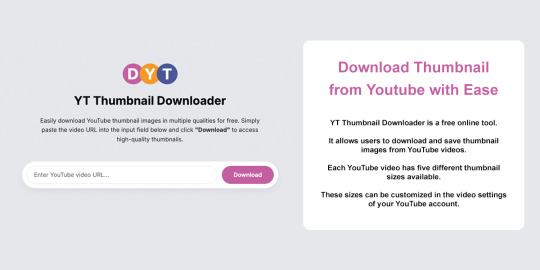
2. Profile Picture Downloader – Get any channel’s profile photo in full resolution.
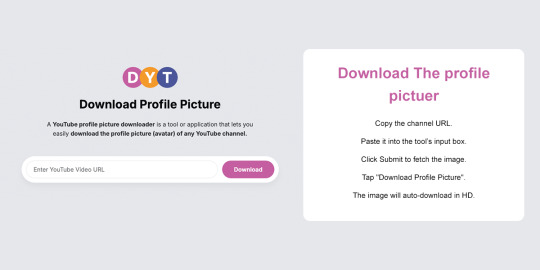
3. Channel Banner Downloader – View and download channel art in one click.

4. YouTube Video Trimmer – Trim and cut YouTube videos online without downloading.

5. Transcript Viewer – Extract subtitles and closed captions from any video.
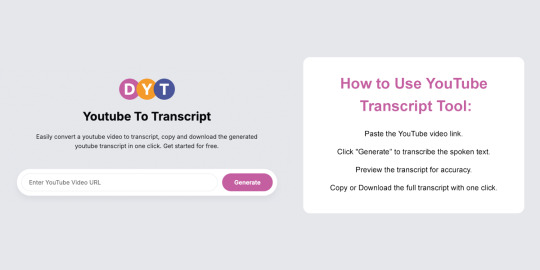
6. YouTube Comment Picker – Run giveaways or pick random winners easily.
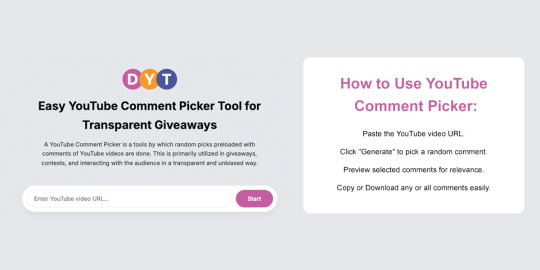
#youtube tools#creator tools#youtube thumbnail#comment picker#downloader#video trimmer#2025 tools#youtube SEO#free online tools#tech tools#ai tools 2025#productivity tools#content tools#seo tools#video tools#best free tools#ai for youtube#automation tools
4 notes
·
View notes
Text
youtube
#social media marketing#grow on X#Twitter growth#content creation strategy#Google Docs system#Deepseek AI#make money online#viral tweets#AI content tools#social media plan#content calendar#affiliate marketing#tweet strategy#personal brand growth#digital product ideas#audience monetization#coaching offers#Twitter threads#content automation#niche selection#Youtube
2 notes
·
View notes
Text
🚀 I Built AutoFillix – A Smart Chrome Extension to Autofill Forms Instantly
Like many developers, I was tired of filling out the same details over and over — name, email, phone number — every time I submitted a job form, Google Form, or sign-up page.
So I built AutoFillix, a smart and secure Chrome extension that:
Autofills common fields (name, email, phone, etc.)
Works on Google Forms and regular web forms
Stores your data locally (no login, no cloud)
Is completely free and easy to use
🔐 Why it’s different:
AutoFillix respects your privacy. Your data stays in your browser — nothing is sent to a server.
🧩 Try It Out:
👉 Install AutoFillix from the Chrome Web Store
💬 Feedback Welcome:
This is just the beginning! If you have suggestions or ideas, feel free to comment. 😊
#chrome extension#web development#programming#productivitytools#technology#software#student life#code#ai tools#automation
2 notes
·
View notes
Text
From Data to Decisions: Leveraging Product Analytics and AI Services for Faster B2B Innovation
In today’s competitive B2B landscape, innovation isn’t just about having a great product idea. It’s about bringing that idea to life faster, smarter, and with precision. That means making every decision based on real data, not guesswork. At Product Siddha, we help businesses unlock faster B2B innovation by combining the power of product analytics and AI services into one seamless strategy.
Why B2B Innovation Fails Without Data-Driven Insight
Most B2B companies struggle to innovate at scale because they lack visibility into what users actually do. Product teams launch features based on assumptions. Marketing teams operate without a feedback loop. Sales teams miss opportunities due to fragmented data. This disconnect creates wasted effort and missed growth.
Product analytics is the solution to this problem. When integrated with AI services, you don’t just track user behavior — you predict it. This lets you make smarter decisions that directly improve your product roadmap, customer experience, and business outcomes.
The Power of Product Analytics in B2B Growth
Product analytics turns user behavior into actionable insight. Instead of relying on vanity metrics, Product Siddha helps you understand how real people interact with your product at every stage. We implement tools that give you a complete view of the user journey — from first touchpoint to long-term retention.
With powerful product analytics, you can:
Identify high-impact features based on real usage
Spot friction points and user drop-offs quickly
Personalize product experiences for higher engagement
Improve onboarding, reduce churn, and boost ROI
This is not just reporting. It’s clarity. It’s control. And it’s the foundation of faster B2B innovation.
Accelerate Outcomes with AI Services That Work for You
While product analytics shows you what’s happening, AI services help you act on that data instantly. Product Siddha designs and builds low-code AI-powered systems that reduce manual work, automate decisions, and create intelligent workflows across teams.
With our AI services, B2B companies can:
Automatically segment users and personalize messaging
Trigger automated campaigns based on user behavior
Streamline product feedback loops
Deliver faster support with AI chatbots and smart routing
Together, AI and analytics make your product smarter and your business more efficient. No more delayed decisions. No more data silos. Just continuous improvement powered by automation.
Our Approach: Build, Learn, Optimize
At Product Siddha, we believe innovation should be fast, measurable, and scalable. That’s why we use a 4-step framework to integrate product analytics and AI services into your workflow.
Build Real, Fast
We help you launch an MVP with just enough features to test real-world usage and start gathering data.
Learn What Matters
We set up product analytics to capture user behavior and feedback, turning that information into practical insight.
Stack Smart Tools
Our AI services integrate with your MarTech and product stack, automating repetitive tasks and surfacing real-time insights.
Optimize with Focus
Based on what you learn, we help you refine your product, personalize your messaging, and scale growth efficiently.
Why Choose Product Siddha for B2B Innovation?
We specialize in helping fast-moving B2B brands like yours eliminate complexity and move with clarity. At Product Siddha, we don’t just give you data or automation tools — we build intelligent systems that let you move from data to decisions in real time.
Our team combines deep expertise in product analytics, AI automation, and B2B marketing operations. Whether you’re building your first product or scaling an existing one, we help you:
Reduce time-to-market
Eliminate development waste
Align product and growth goals
Launch with confidence
Visit Product Siddha to explore our full range of services.
Let’s Turn Insight into Innovation
If you’re ready to use product analytics and AI services to unlock faster B2B innovation, we’re here to help. Product Siddha builds smart, scalable systems that help your teams learn faster, move faster, and grow faster.
Call us today at 98993 22826 to discover how we can turn your product data into your biggest competitive advantage.
2 notes
·
View notes
Text
Stackpack Secures $6.3M to Reinvent Vendor Management in an AI-Driven Business Landscape
New Post has been published on https://thedigitalinsider.com/stackpack-secures-6-3m-to-reinvent-vendor-management-in-an-ai-driven-business-landscape/
Stackpack Secures $6.3M to Reinvent Vendor Management in an AI-Driven Business Landscape


In a world where third-party tools, services, and contractors form the operational backbone of modern companies, Stackpack has raised $6.3 million to bring order to the growing complexity.
Led by Freestyle Capital, the funding round includes support from Elefund, Upside Partnership, Nomad Ventures, Layout Ventures, MSIV Fund, and strategic angels from Intuit, Workday, Affirm, Snapdocs, and xAI.
The funding supports Stackpack’s mission to redefine how businesses manage their expanding vendor networks—an increasingly vital task as organizations now juggle hundreds or even thousands of external partners and platforms.
Turning Chaos into Control
Founded in 2023 by Sara Wyman, formerly of Etsy and Affirm, Stackpack was built to solve a problem she knew too well: modern companies are powered by vendors, yet most still track them with outdated methods—spreadsheets, scattered documents, and guesswork. With SaaS stacks ballooning and AI tools proliferating, unmanaged vendors become silent liabilities.
“Companies call themselves ‘people-first,’ but in reality, they’re becoming ‘vendor-first,’” said Wyman. “There are often 6x more vendors than employees. Yet there’s no system of record to manage that shift—until now.”
Stackpack gives finance and IT teams a unified, AI-powered dashboard that provides real-time visibility into vendor contracts, spend, renewals, and compliance risks. The platform automatically extracts key contract terms like auto-renewal clauses, flags overlapping subscriptions, and even predicts upcoming renewals buried deep in PDFs.
AI That Works Like a Virtual Vendor Manager
Stackpack’s Behavioral AI Engine acts as an intelligent assistant, surfacing hidden cost-saving opportunities, compliance risks, and critical dates. It not only identifies inefficiencies—it takes action, issuing alerts, initiating workflows, and providing recommendations across the vendor lifecycle.
For instance:
Renewal alerts prevent surprise charges.
Spend tracking identifies underused or duplicate tools.
Contract intelligence extracts legal and pricing terms from uploads or integrations with tools like Google Drive.
Approval workflows streamline onboarding and procurement.
This brings the kind of automation once reserved for enterprise procurement platforms like Coupa or SAP to startups and mid-sized businesses—at a fraction of the cost.
A Timely Solution for a Growing Problem
Vendor management has become a boardroom issue. As more companies shift budgets from headcount to outsourced services, compliance and financial oversight have become harder to maintain. Stackpack’s early traction is proof of demand: just months after launch, it’s managing over 10,500 vendors and $510 million in spend across more than 50 customers, including Every Man Jack, Rho, Density, HouseRx, Fexa, and ZeroEyes.
“The CFO is the one left holding the bag when things go wrong,” said Brandon Lee, Accounting Manager at BizzyCar. “Stackpack means we don’t have to cross our fingers every quarter.”
Beyond Visibility: Enabling Smarter Vendor Decisions
Alongside its core platform, Stackpack is launching Requests & Approvals, a lightweight tool to simplify vendor onboarding and purchasing decisions—currently in beta. The feature is already attracting customers looking for faster, more agile alternatives to traditional procurement systems.
With a long-term vision to help companies not only manage but discover and evaluate vendors more strategically, Stackpack is laying the groundwork for a smarter, interconnected vendor ecosystem.
“Every vendor decision carries legal, financial, and security consequences,” said Dave Samuel, General Partner at Freestyle Capital. “Stackpack is building the intelligent infrastructure to manage these relationships proactively.”
The Future of Vendor Operations
As third-party ecosystems grow in size and complexity, Stackpack aims to transform vendor operations from a liability into a competitive advantage. Its AI-powered approach gives companies a modern operating system for vendor management—one that’s scalable, proactive, and deeply integrated into finance and operations.
“This isn’t just about cost control—it’s about running a smarter company,” said Wyman. “Managing your vendors should be as strategic as managing your talent. We’re giving companies the tools to make that possible.”
With fresh funding and a rapidly expanding customer base, Stackpack is poised to become the new standard for how modern businesses manage the partners powering their growth.
#2023#accounting#agile#ai#ai tools#AI-powered#alerts#amp#approach#automation#Behavioral AI#budgets#Building#Business#CFO#chaos#Companies#complexity#compliance#dashboard#dates#documents#EARLY#Ecosystems#employees#engine#enterprise#finance#financial#form
2 notes
·
View notes
Text
How AI & Machine Learning Are Changing UI/UX Design

Artificial Intelligence (AI) and Machine Learning (ML) are revolutionizing UI/UX design by making digital experiences more intelligent, adaptive, and user-centric. From personalized interfaces to automated design processes, AI is reshaping how designers create and enhance user experiences. In this blog, we explore the key ways AI and ML are transforming UI/UX design and what the future holds.
For more UI/UX trends and insights, visit Pixelizes Blog.
AI-Driven Personalization
One of the biggest changes AI has brought to UI/UX design is hyper-personalization. By analyzing user behavior, AI can tailor content, recommendations, and layouts to individual preferences, creating a more engaging experience.
How It Works:
AI analyzes user interactions, including clicks, time spent, and preferences.
Dynamic UI adjustments ensure users see what’s most relevant to them.
Personalized recommendations, like Netflix suggesting shows or e-commerce platforms curating product lists.
Smart Chatbots & Conversational UI
AI-powered chatbots have revolutionized customer interactions by offering real-time, intelligent responses. They enhance UX by providing 24/7 support, answering FAQs, and guiding users seamlessly through applications or websites.
Examples:
Virtual assistants like Siri, Alexa, and Google Assistant.
AI chatbots in banking, e-commerce, and healthcare.
NLP-powered bots that understand user intent and sentiment.
Predictive UX: Anticipating User Needs
Predictive UX leverages ML algorithms to anticipate user actions before they happen, streamlining interactions and reducing friction.
Real-World Applications:
Smart search suggestions (e.g., Google, Amazon, Spotify).
AI-powered auto-fill forms that reduce typing effort.
Anticipatory design like Google Maps estimating destinations.
AI-Powered UI Design Automation
AI is streamlining design workflows by automating repetitive tasks, allowing designers to focus on creativity and innovation.
Key AI-Powered Tools:
Adobe Sensei: Automates image editing, tagging, and design suggestions.
Figma AI Plugins & Sketch: Generate elements based on user input.
UX Writing Assistants that enhance microcopy with NLP.
Voice & Gesture-Based Interactions
With AI advancements, voice and gesture control are becoming standard features in UI/UX design, offering more intuitive, hands-free interactions.
Examples:
Voice commands via Google Assistant, Siri, Alexa.
Gesture-based UI on smart TVs, AR/VR devices.
Facial recognition & biometric authentication for secure logins.
AI in Accessibility & Inclusive Design
AI is making digital products more accessible to users with disabilities by enabling assistive technologies and improving UX for all.
How AI Enhances Accessibility:
Voice-to-text and text-to-speech via Google Accessibility.
Alt-text generation for visually impaired users.
Automated color contrast adjustments for better readability.
Sentiment Analysis for Improved UX
AI-powered sentiment analysis tools track user emotions through feedback, reviews, and interactions, helping designers refine UX strategies.
Uses of Sentiment Analysis:
Detecting frustration points in customer feedback.
Optimizing UI elements based on emotional responses.
Enhancing A/B testing insights with AI-driven analytics.
Future of AI in UI/UX: What’s Next?
As AI and ML continue to evolve, UI/UX design will become more intuitive, adaptive, and human-centric. Future trends include:
AI-generated UI designs with minimal manual input.
Real-time, emotion-based UX adaptations.
Brain-computer interface (BCI) integrations for immersive experiences.
Final Thoughts
AI and ML are not replacing designers—they are empowering them to deliver smarter, faster, and more engaging experiences. As we move into a future dominated by intelligent interfaces, UI/UX designers must embrace AI-powered design methodologies to create more personalized, accessible, and user-friendly digital products.
Explore more at Pixelizes.com for cutting-edge design insights, AI tools, and UX trends.
#AI in UX Design#Machine Learning UX#UX Personalization#Conversational UI#Predictive UX#AI Chatbots#Smart UX Tools#UI Automation#Voice UI Design#Inclusive UX Design#Sentiment Analysis in UX#Future of UX#AI UX Trends 2025#Figma AI Plugins#Accessibility with AI#Adaptive UI Design#UX Innovation#Human-Centered AI#Pixelizes Blog#UX Strategy
2 notes
·
View notes
Text
Discover Aipedia: The Ultimate AI Tools Directory
Introducing Aipedia – The Ultimate AI Tools Directory!
AI is transforming industries, and finding the right AI tools can be overwhelming. That’s why we created Aipedia – a curated directory of AI tools for content creation, automation, SEO, video editing, and more!
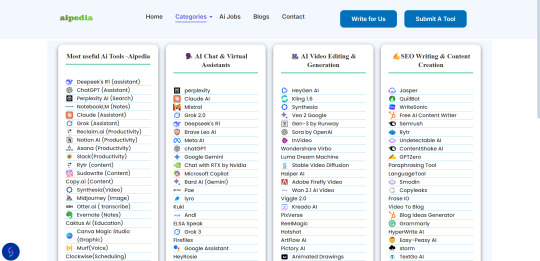
🌟 Why Choose Aipedia?
✅ Comprehensive AI Listings – Find AI tools across multiple categories. ✅ Easy Search & Filters – Discover tools based on pricing and features. ✅ Regular Updates – Stay updated with the latest AI innovations. ✅ Submit Your AI Tool – AI developers can list their tools for exposure.
🔍 Explore Aipedia Now: Aipedia.in
📢 Join the AI Revolution & Supercharge Your Productivity!
#ai#ai content creation#ai tools#artificial intelligence#machinelearning#ai model#ai generated#character ai#ai art#ai automation#aipedia
2 notes
·
View notes